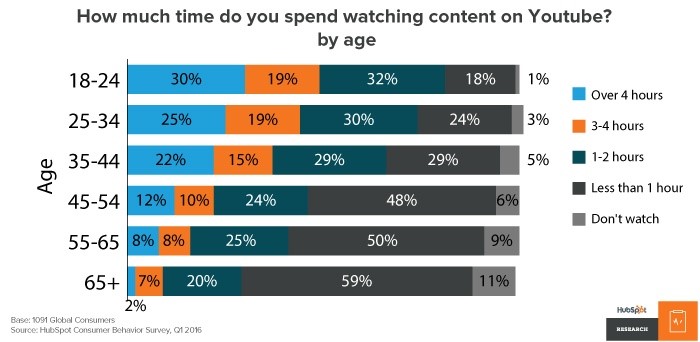Implementing a Video Marketing Strategy
We keep hearing it everywhere we go – in the classroom, at conferences, in meetings – video is the future of marketing. The reality is, video isn’t the future of marketing – video is NOW. Video marketing, especially through platforms like Facebook and YouTube, provides consumers with a quick overview of a product or service, allowing them to get the information they need in mere seconds. Many Millennials and Gen Ys have expressed video as being a primary source to obtain information, with 30% of consumers aged 18-24 consuming over four hours of YouTube content a week!
 For many traditional marketers, the concept of implementing a video strategy can be terrifying. The most common fear is about content creation: how am I ever going to create original content that will capture the attention of my audience and convert? There is nothing worse than dumping hours of time and countless dollars into a video endeavor, posting it online, anxiously refreshing your browser monitoring the video traffic only to realize that your audience is not receptive. Don’t worry, every brand has had their share of bad first videos before they mastered video marketing. The key is to learn from these mistakes – and try again.
For many traditional marketers, the concept of implementing a video strategy can be terrifying. The most common fear is about content creation: how am I ever going to create original content that will capture the attention of my audience and convert? There is nothing worse than dumping hours of time and countless dollars into a video endeavor, posting it online, anxiously refreshing your browser monitoring the video traffic only to realize that your audience is not receptive. Don’t worry, every brand has had their share of bad first videos before they mastered video marketing. The key is to learn from these mistakes – and try again.
The Ultimate Cheat Sheet
It’s time to stop making excuses as to why you aren’t using video as part of your marketing strategy. This post is designed to help you implement a video strategy. Here’s some easy tips to aid you in creating video content that converts.
Tip #1: Define Your Audience.
“Who is my target audience?” – before you spend any money or time on content creation, you first need to ask yourself this question. If you cannot define your consumer, how are you supposed to use video to engage with them? In order to create a truly engaging video that converts, you need to understand your audience’s problems, pain points, questions, habits, and interests. Once you define this, you can begin developing a strategy that with cater to this audience, providing them with the solutions, remedies, answers, and ideas that they are looking for.
Tip #2: Use Keywords.
Okay great, we know who our consumer is, time for the fun part – to create some content! The first step is to decide on a few keywords that will effectively explain the message you are trying to communicate. You may want to integrate these keywords into the title or description of your video, and throughout the video using calls-to-action. By establishing these keywords, you are creating focused content that will keep viewers engaged. When a viewer clicks on a video, they need to know exactly what information they are going to receive by watching it. Unfocused, generic, or ambiguous content is the easiest way to lose a viewer’s interest – do not harm your videos conversion rates by falling victim to information overload.
Tip #3: Un-Branding.
We get it, you want viewers to know that the video belongs to you – however, you can do this without having your brand name or logo jumping out at the consumer throughout the entire video. No one wants to share an advertisement that is very obviously an advertisement. Some branding is definitely necessary. However, this can be achieved by simply flashing your logo for a few seconds at the beginning or end of the video, or by using memorable design cues throughout the video that are unique to your brand identity. Minimal branding, especially in the case of blatantly obvious branding, is crucial in generating likes and shares, especially on social media.
Tip #4: Text Integration.
Did you know that over 80% of videos are watched muted? This means that as marketers, we need to find ways to create engaging videos without the use of audio. Integration of text throughout the video is critical in order to communicate your message to these silent video-watchers. Captions are a great way to ensure that your whole message is being received. Additionally, you can use calls-to-action in the form of graphics to help communicate your message throughout the video. These can also be used to complement your audio, showing information that is not audibly mentioned.
Tip #5: Keep It Short & Sweet.
On YouTube, you have roughly eight seconds to gain the interest of a consumer – this is even less on Facebook. Once you have captured their attention, you want to keep it throughout the duration of the entire video. This will be very difficult to do if your video is too long. Keeping your video short and to the point is critical if you want your video to convert. A short and focused video also increases the likelihood that your consumer will watch the entire video and receive all the information that you are sharing with them. When you are developing your initial video strategy, decide how long you want your video to be (keeping it under a minute is normally an effective strategy) and stick to it. This will ensure that your content remains focused.
Apps like Snapchat, which only allows video posts to be ten seconds, are drastically changing the consumer’s expectation of what is “too long” for video. As a result, consumers are expected to lose interest even more quickly in the future, which is something to keep in mind as your video strategy develops throughout the coming years.
Tip #6: Post Strategically.
Once you’ve created your video content, the next step is to decide where to post it. If you are trying to compete in an already over-saturated video market, it may be wise to focus your video marketing strategy on platforms where no one else is investing. Popular video platforms, such as Facebook, are becoming increasingly saturated. Although Facebook currently has the the highest video engagement rates, return on investment for Facebook video initiatives is projected to decline in the future due to increased competition. Therefore, investment in alternative emerging video platforms, such as Snapchat and Instagram Stories, may offer you a higher long term return on investment.
It is also beneficial to execute staggered video launch timing across different platforms. If you have a blog or brand website, post your video there first. This will generate traffic to your brand website. Then, perhaps a few days (or even weeks or months) later, you can upload the video to other platforms, such as YouTube or Facebook, to generate further reach. By releasing content first to your own platform, you are also keeping your loyal customers happy, making them feel like it was worth their while to subscribe to your website or blog.
Do you feel ready to create your video yet?
There’s one last, extremely critical step to consider when implementing a video marketing strategy. Before you post, ask yourself: “Would I share this video?” If you wouldn’t share it, why would others? Creating video simply for the sake of creating video is not a winning strategy. The primary goal of any video marketer should be to create a video that the audience feels compelled to share. To do this, you need to be strategic with your video efforts – and use this cheat sheet as a guide to make great videos that convert!



